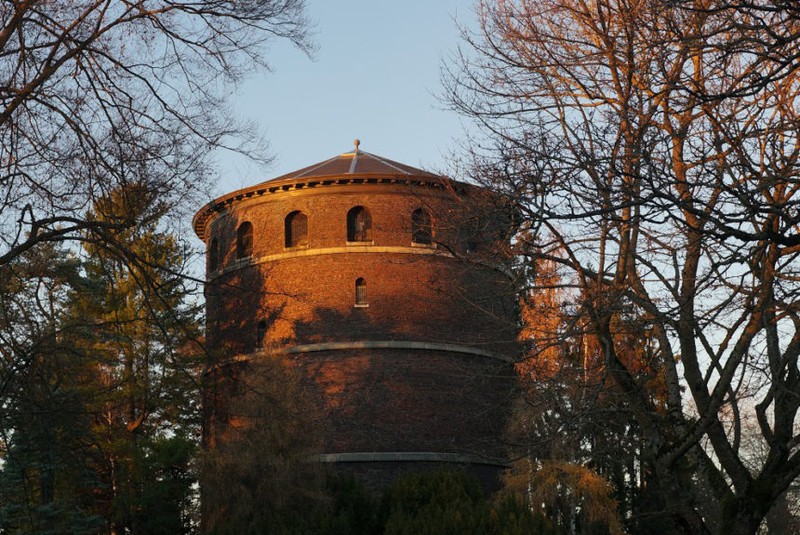Water Tower and Observation Deck (Volunteer Park)
Introduction
Text-to-speech Audio
Completed in 1907, this brick water tower is located in the southeast corner of Seattle's Volunteer Park, which evolved from an earlier city park through recommendations made by the Olmsted Brothers firm in 1903. As one of the park's signature landmarks, the 76-foot tower sits on top of Capitol Hill at a total elevation of 520 feet. The tower encloses an 883,000-gallon steel standpipe installed as part of the city's Cedar River Water System following the establishment of a reservoir on Capitol Hill in 1901. An interior stairway spirals up to the tower's observation deck, which offers panoramic views of Elliot Bay, the Olympic Mountains, Puget Sound, and downtown Seattle to the southwest, as well as Lake Washington and Bellevue to the east. Included in the listing for Volunteer Park and Seattle's early 20th-century water system infrastructure, the tower was added to the National Register of Historic Places in 1976.
Images
The Water Tower in Volunteer Park

Water Tower and Lily Pond, 1930

Backstory and Context
Text-to-speech Audio
This brick water tower was completed in 1907 by the Seattle Water Department in order to improve water pressure in the Capitol Hill area. It was also intended to provide an observation deck for Volunteer Park, which had evolved from an earlier city park at this location. At the time, Capitol Hill was a heavily wooded and relatively inaccessible area beyond the city limits. The Seattle Water Department decided that the hilltop was an ideal location for the creation of a reservoir, as gravity could be harnessed to channel the water downward to the city. In 1901, a reservoir was established, and in 1903, the city commissioned the Olmsted Brothers landscape architecture firm to make recommendations for the improvement of the earlier city park located near the site.
From 1904 to 1912, the city park was slowly improved in accordance with the Olmsted Brothers' detailed plan. As it evolved to become Seattle's Volunteer Park, further acreage was acquired by the city, adding to the park's square footage over time. As part of the Olmsted Brothers' recommendations for the park, they suggested that the city construct an observation deck that could serve as a public viewing area, offering visitors a sweeping panorama of the park and city beyond. Their suggestion was implemented by the Seattle Water Department in 1906, with an observation deck incorporated into the design of the 76-foot tall water tower.
The water tower's elegant red brick exterior obscured its basic utilitarian purpose: enclosing an 883,000-gallon steel standpipe for the new Cedar River Water System. The tower also blended in with the wooded surroundings of the park and was architecturally stylish enough to blend with the fashionable neighborhood that was emerging around Capitol Hill. Today, the tower's observation deck is a destination for unobscured views of downtown Seattle, Puget Sound, and the Olympic Mountains. It is also a popular spot for photography. The water tower remains noteworthy for its connections to the Olmsted Brothers and the public parks movement. Included in the listing for Volunteer Park and Seattle's early 20th-century water system infrastructure, the tower was added to the National Register of Historic Places in 1976.
Sources
Ott, Jennifer. Olmsted in Seattle: Creating a Park System for a Modern City. Seattle, WA. HistoryLink, 2019.
"Seattle Historical Sites", Seattle.gov. Accessed August 10th, 2023. https://web.seattle.gov/DPD/HistoricalSite/QueryResult.aspx?ID=1206048203#.
"Volunteer Park", City of Seattle. Accessed August 10th, 2023. https://www.seattle.gov/parks/allparks/volunteer-park.
"Volunteer Park and Water System Historic District: Nomination Form, National Register of Historic Places", National Archives. May 3rd, 1976. Accessed August 10th, 2023. https://catalog.archives.gov/id/75612436.
"Water Tower - Volunteer Park", Volunteer Park Trust. Accessed August 10th, 2023. https://volunteerparktrust.org/profile/water-tower/.
HistoryLink / Courtesy of Seattle Municipal Archives
